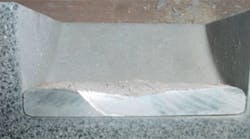Zinc is an excellent metallic material for diecasting because of its fluidity and viscosity, but these factors also present problems for molten metal containment: its fluidity means that it exploits any imperfections in the refractory lining, degrading the insulating properties. The rapid buildup of zinc slag on the lining decreases the service life of the refractory — increasing material and maintenance costs.
Blasch Precision Ceramics develops refractories for a wide range of molten metal applications, including diecasting and foundry operations. Its Altron product line is an alumina-bonded silicon carbide that Blasch says can be formed into intricate and precise shapes. It reportedly exhibits exceptional oxidation and thermal shock resistance, and Blasch indicates it has the wear- and corrosion-resistance that addresses the problems presented by zinc slag buildup in melting and holding vessels.
Tests of the Altron material that Blasch conducted evaluated the use of cast-zinc button samples, as well as dross and skimmings from a zinc diecasting manufacturer. Altron cup brick shapes were fabricated for these tests.
As detailed by the developer, zinc melt materials were placed in cup bricks and then fired on a laboratory kiln. The kiln firing schedule was a ramp-up of 100°C/hour to 815°C; followed by a 72-hour hold; then cooling down to room temperature at 100°C/ hour. The fired cup brick samples were sectioned using a diamond tipped blade.
As shown in the photo series, no melt infiltration occurred with any of the three zinc melt samples. All three types of melt materials were easily removed from the cup brick surface, either by hand or during sectioning, as seen the photos of the dross and metal button sections separated from the cup brick samples.
Altron features excellent thermal shock characteristics, and its wear-resistance approaches the performance of materials that are two to four times its cost, according to Blasch. It also features close as-cast dimensional control and repeatable dimensions. It will lasts longer than steels and rubber, and won’t crack at high temperatures or during severe temperature changes. It also reduces spalling and erosion.
Altron material is available as forms that include nozzles, burner tiles, cyclones, spigots, impeller rings, apexes, valves, cones, chutes, micronizers, vessel and pipe linings.














